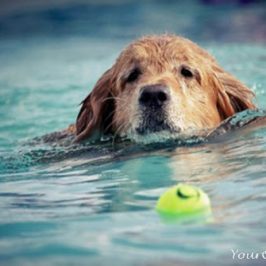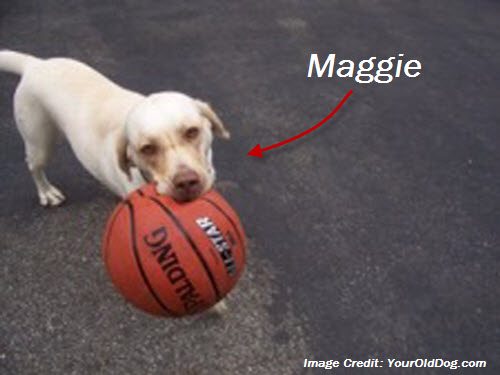
All Dogs Can’t Swim or At Least Aren’t Good Swimmers
I used to believe that all dogs could swim and that they were all good at it too.
Especially the water dogs such as Labrador Retrievers, Goldens, Portuguese Water Dogs, etc.
It wasn’t until after getting my first Labrador Retriever Lulu, that I discovered that all dogs (including those that were bred to do so) don’t instinctively like it, nor are they instinctively good at it. It’s not at all characteristic for all dogs to dive into the water and paddle around.
Although I do have to say that Lulu had a bad wrist from the time we brought her home from the HS when she was just two. So, it’s probably not fair to say that she didn’t like to swim, because each time she tried, she would limp after wards and often hold her paw up crying.
After our beloved Lulu passed in 2010, we rescued another yellow lab named Maggie and she’s a completely different story. Maggie was born to swim. She gets excited at the very sight of water and there is NO holding her back!
So, when it comes to swimming, it’s important to understand that if your dog is reluctant, maybe he or she’s isn’t a confident swimmer. Don’t push the issue, especially in deep water (oceans and lakes, rivers, etc.). A life vest made specifically for dogs is highly recommended.
5 Tips To Introduce Your Dog To Water

- The best approach to get a dog used to water is to introduce them to it as early as possible; preferably as a puppy. However, if you rescue an older dog like we did with Lulu (age 2) and the dog isn’t comfortable with water – don’t force, but work with her slowly.
- If you’re teaching your dog to swim, it’s important to make the experience a happy one. One that the dog will want to repeat.
- NEVER allow a dog in water that is over their head until they are completely comfortable and skilled swimmers.
- NEVER force or throw the dog in water. Besides being cruel, this will only make the dog’s experience a bad one.
- Work slowly with your dog and use a dog swim vest or life jacket initially until your dog’s comfortable and you know he’s an accomplished swimmer.
Know The Risks
- This is a big one for those with a swimming pool in the back yard. Emergency room vets see this quite often! Dogs who are used to swimming in the pool will walk across the pool cover – the cover collapses and the dog gets trapped, inhales water and possibly loses his life. If you own a pool and there’s a good chance that your dog will walk across the cover, invest in a safety cover designed to protect kids and pets from this very accident. They’re more expensive, but worth every penny.
- If you take your dog swimming at the beach, always take fresh water for your dog and offer it to him often. If your dog ingests a lot of salt water (drinking all day), there’s a chance that he could develop “acute salt intoxication”. Symptoms include vomiting, dullness and depression. Prevent by taking fresh water to the beach for Fido.
- Dogs who swim or drink from fresh water streams are at risk of becoming infected with the “giardia” parasite. Symptoms include vomiting and diarrhea (diarrhea often ongoing). See my article here on treating diarrhea in dogs.
- Ponds harbor molds that cause many problems including neurological issues, liver disease and liver failure.
- Know when your dog has had enough. Since dogs do not float, they tire faster from paddling so much. Just because your dog will keep jumping into the water and retrieving his ball because you threw it, doesn’t mean he’s not tired. Set a time limit for your dog. DON’T exhaust him.
- Dogs pant simply to regulate their body temperature. It cools them down. However, if you hear your dog making strange sounds such as squeaking or rattling – it’s time to stop and take a break.
- Sunburn can be an issue for dogs who are fair and/or have little pigmentation around the nose and eye lids. There are vests that you can buy that will block the ultra violet rays and you can also use sunscreens that are made for dogs and they repel them from licking it. Sunburn or constant exposure can lead to skin cancer for dogs too.
- Rinse your dog off when you return from the beach. Sand gets trapped in their fur and between their toes. For dogs with either a soft or a thick coat, brush them out. Wet coats hold bacteria.
- Good toys for the water are ones that will float and are easy to grab.










